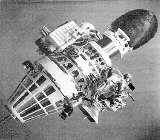
Luna 7
Encyclopedia
Luna 7 was an unmanned space mission of the Soviet
Luna program, also called Lunik 7. The Luna 7 spacecraft was intended to achieve a soft landing on the Moon
. However, due to premature retrofire and cutoff of the retrorockets, the spacecraft impacted the lunar surface in Oceanus Procellarum
.
Unlike its predecessors, Luna 7 successfully carried out its mid-course correction on October 5 on the way to the Moon, in anticipation of a soft-landing two days later. Unfortunately, immediately prior to planned retro-fire during the approach to the lunar surface, the spacecraft suddenly lost attitude control and failed to regain it. Automatic programmed systems then prevented the main engine from firing. As controllers observed helplessly, Luna 7 plummeted to the lunar surface at a very high speed, crashing at 22:08:24 UT on October 7, 1965, west of the Kepler crater
, relatively near the actual intended target. Impact coordinates were . Later investigation indicated that the optical sensor of the astronavigation
system had been set at the wrong angle and had lost sight of Earth during the critical attitude-control maneuver. It was the tenth consecutive failure in the Ye-6 program.
Soviet Union
The Soviet Union , officially the Union of Soviet Socialist Republics , was a constitutionally socialist state that existed in Eurasia between 1922 and 1991....
Luna program, also called Lunik 7. The Luna 7 spacecraft was intended to achieve a soft landing on the Moon
Moon
The Moon is Earth's only known natural satellite,There are a number of near-Earth asteroids including 3753 Cruithne that are co-orbital with Earth: their orbits bring them close to Earth for periods of time but then alter in the long term . These are quasi-satellites and not true moons. For more...
. However, due to premature retrofire and cutoff of the retrorockets, the spacecraft impacted the lunar surface in Oceanus Procellarum
Oceanus Procellarum
Oceanus Procellarum is a vast lunar mare on the western edge of the near side of the Earth's Moon. Its name derives from the old superstition that its appearance during the second quarter heralded bad weather...
.
Unlike its predecessors, Luna 7 successfully carried out its mid-course correction on October 5 on the way to the Moon, in anticipation of a soft-landing two days later. Unfortunately, immediately prior to planned retro-fire during the approach to the lunar surface, the spacecraft suddenly lost attitude control and failed to regain it. Automatic programmed systems then prevented the main engine from firing. As controllers observed helplessly, Luna 7 plummeted to the lunar surface at a very high speed, crashing at 22:08:24 UT on October 7, 1965, west of the Kepler crater
Kepler (lunar crater)
Kepler is a lunar impact crater that lies between the Oceanus Procellarum to the west and Mare Insularum in the east. To the southeast is the crater Encke....
, relatively near the actual intended target. Impact coordinates were . Later investigation indicated that the optical sensor of the astronavigation
Celestial navigation
Celestial navigation, also known as astronavigation, is a position fixing technique that has evolved over several thousand years to help sailors cross oceans without having to rely on estimated calculations, or dead reckoning, to know their position...
system had been set at the wrong angle and had lost sight of Earth during the critical attitude-control maneuver. It was the tenth consecutive failure in the Ye-6 program.

